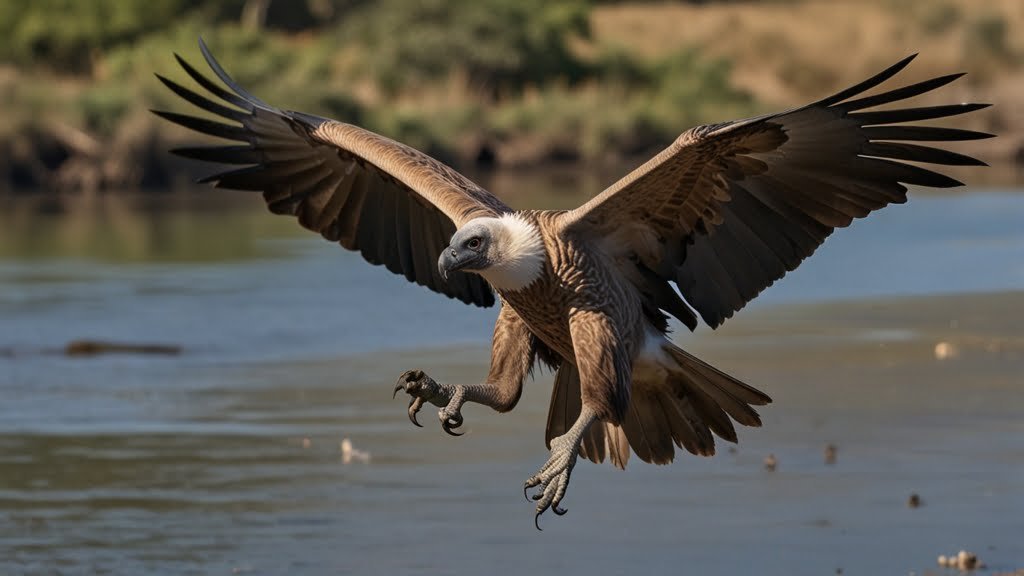Introduction
The white-backed vulture (Gyps africanus) stands out as one of nature’s most intriguing scavengers, a bird that commands attention with its striking plumage and indispensable ecological role. Indigenous to the vast expanses of sub-Saharan Africa, this vulture isn’t just a fascinating creature but a vital cog in the ecosystem’s machinery. Join us as we unravel six compelling facts about the white-backed vulture, diving into its unique behaviors, habitats, and the urgent conservation issues it faces.
1. Distinctive Features of the White-Backed Vulture
With its iconic white feathers cascading down its back and shoulders, the white-backed vulture is impossible to miss. This majestic bird boasts a wingspan of up to 2.5 meters (8.2 feet) and a weight ranging from 4 to 7 kilograms (8.8 to 15.4 pounds). Its formidable beak and sharp eyesight make it an exceptional scavenger, adept at spotting carrion from impressive distances.

2. Habitat and Distribution
The white-backed vulture thrives in the diverse landscapes of sub-Saharan Africa, from savannas to open woodlands and grasslands. These regions are rich in carrion, which forms the cornerstone of their diet. Notable locations where these vultures can be observed include:
- South Africa: Home to several populations in protected reserves such as Kruger National Park.
- Tanzania: The vast Serengeti National Park offers an ideal habitat teeming with food sources.
- Kenya: Amboseli National Park supports a flourishing community of white-backed vultures.
These habitats provide the essential resources needed for their survival, including ample food and suitable nesting sites.
3. Feeding Habits and Diet
Feeding predominantly on carrion, the white-backed vulture employs its remarkable vision to detect dead animals from afar. This dietary preference not only plays a pivotal role in nutrient cycling but also helps curtail the spread of disease. Their digestive systems are uniquely adapted to process and neutralize the pathogens and toxins found in decomposing flesh.
4. Reproductive Behavior and Nesting
Known for their substantial nests, white-backed vultures typically construct these platforms in the tallest trees available. During the breeding season, the female lays one or two eggs. Both parents are deeply involved in incubating these eggs for about 50 to 55 days and subsequently feeding their chicks. The young vultures remain in the nest for several months, subsisting on regurgitated food as they grow and develop.
5. Conservation Challenges
The white-backed vulture is classified as “Critically Endangered” by the International Union for Conservation of Nature (IUCN). The primary threats to its survival are:
- Poisoning: Intentional poisoning of carcasses intended for other wildlife inadvertently affects vultures.
- Habitat Loss: Rapid deforestation and land conversion are shrinking their natural habitats.
- Human-Wildlife Conflict: Encroachment and persecution further exacerbate their plight.
Efforts to counteract these threats include anti-poisoning campaigns and habitat protection strategies.

6. The Critical Role of Vulture Conservation
Conserving the white-backed vulture is not just about protecting a single species—it’s about maintaining the balance of entire ecosystems. These vultures provide an essential service by cleaning up carrion, thus preventing potential disease outbreaks. Supporting vulture conservation helps preserve the delicate balance of nature and ensures the health of the environment.
Conclusion
The white-backed vulture is far more than a striking scavenger; it is a crucial player in the ecological tapestry of Africa. Despite facing numerous threats, the ongoing conservation efforts are vital in securing a future for this magnificent bird. By fostering awareness and backing protective measures, we contribute to the preservation of the white-backed vulture and the ecosystems it supports.



